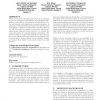Free Online Productivity Tools
i2Speak
i2Symbol
i2OCR
iTex2Img
iWeb2Print
iWeb2Shot
i2Type
iPdf2Split
iPdf2Merge
i2Bopomofo
i2Arabic
i2Style
i2Image
i2PDF
iLatex2Rtf
Sci2ools
94
Voted
GIS
2009
ACM
2009
ACM
A salience-based approach for the modeling of landscape descriptions
While conventional GIS maps have long been a privileged way for the integration and diffusion of geographical information, novel forms of representation and description of urban and natural environments are nowadays emerging. In particular, verbal and textual descriptions of landscapes are progressively considered as alternative modeling resources for GIS. The research presented in this paper introduces a salience-based approach whose objective is to identify the noticeable entities of a natural landscape description. The model is based on a structural analysis of a given description, where salient entities are identified at the linguistic and structural levels. Salient entities are also spatially qualified according to their relative location with respect to a given observer. Categories and Subject Descriptors H.4 [Information Systems Applications]: Miscellaneous; I.2.7 [Artificial intelligence]: Natural Language Processing General Terms Human factors, Algorithms Keywords Spatial...
Related Content
| Added | 19 May 2010 |
| Updated | 19 May 2010 |
| Type | Conference |
| Year | 2009 |
| Where | GIS |
| Authors | Jean-Marie Le Yaouanc, Eric Saux, Christophe Claramunt |
Comments (0)

